When you manage an in-office team, it’s relatively easy to tell if an employee isn’t doing their job. You can simply stop by their desk or set up in-person check-ins. However, monitoring remote employees isn’t quite as straightforward.
At Time Doctor, we’ve been growing our remote team for over a decade. We’ve learned a few things about encouraging remote employees to stay focused while giving them space to do their jobs. As a result, we have plenty of firsthand experience balancing accountability with transparency.
In this article, we’ll cover reliable ways to check whether your team is actually working and show how our automatic time tracking platform can keep everyone accountable.
Table of Contents
- 8 ways to find out if a remote employee isn’t working
- How Time Doctor can confirm if your remote team is actually working
- Next steps to get started with remote employee monitoring
8 ways to find out if a remote employee isn’t working
It’s natural to wonder if remote team members are working, especially if you don’t have regular check-ins scheduled. But there’s no need to question your team constantly. Use our tips to spot the signs of idle workers and take appropriate action.
1. Analyze attendance records
The most straightforward way to check if employees are working is to review their attendance records. Do they report for all their scheduled shifts? How many unplanned or unapproved absences have they had in the past quarter?
It’s also essential to check when they log in and out. Do they tend to be on time or early and complete all scheduled work hours? Or do they tend to arrive late and log out early?
Employees with higher rates of absenteeism and tardiness may not be working as hard as others on the same team. Before taking disciplinary action, set up a one-on-one with each underperformer to find out what’s broken and how to fix it.
2. Confirm whether they’re finishing tasks
Another easy way to tell if a remote team member has fallen behind is to check whether they’ve completed their tasks and projects. To do this, compare the number of tasks assigned to the number of tasks completed. Use your organization’s project management tool to make the comparison as easy as possible.
If your employees have several outstanding tasks, they may not be working their scheduled shifts or using their time wisely. While you may want to avoid confrontation, one-on-one conversations can help you find the root cause. For example, issues like a lack of resources or tools may affect an employee’s ability to deliver.
If your employees complete assigned tasks successfully, then they’re definitely working. However, what if their work isn’t at the level of quality or on the timeline you expect? Let’s examine that next.
3. Review the quality of their work
Your remote employees may be completing tasks as assigned, but does their work meet your standards? Depending on the nature of your business and the type of work your employees do, your quality assurance methods may look a little different.
For businesses with deliverables, review the workflows for recent tasks. Did some projects require employees to complete multiple rounds of revisions? If so, their work quality may be substandard and require a performance review.
For call centers that provide customer service, measure recent customer satisfaction scores. Do some team members regularly receive low scores? Look for patterns in these reviews to pinpoint and address performance issues.
For any organization that depends on collaboration, poll other team members about their colleagues’ quality of work. Do some remote employees receive low marks from colleagues? Look for common issues so you can help employees improve.
4. Check if they’re missing deadlines
Your team may be delivering great work, but what if they tend to run behind schedule? These delays can slow down the rest of your team, creating more significant issues for clients and stakeholders.
To check the timeliness of your team’s performance, use your organization’s project management tool. Look for projects that are behind schedule or tasks completed after the deadline. Note the person responsible for these tasks.
An occasional missed deadline may not be a warning sign. However, if you spot repeat offenders, take action before lateness becomes the norm. Schedule check-ins to learn more about why employees missed deadlines.
Sometimes, you may learn that limited resources or access to team members were contributing factors. In other cases, your team may be experiencing low motivation, poor internet access, or confusion about assignments.
5. Compare their active to idle time
Reporting for work on time is one thing, but what do your remote employees do after signing on for the day? Are they available when you expect them to be, or are they unreachable for long periods of the day?
In many cases, a typical shift lasts for eight hours. However, employees won’t be actively working the entire time. Depending on their roles, your team may need time to research, process, strategize, or decompress.
For every role, get a sense of what’s typical for active time versus idle time. For example, entry-level developers may average more active time than middle managers. Then, compare all employees’ activity against these benchmarks.
If some employees have significantly more idle time than their peers, schedule a check-in to learn why. Go beyond general excuses to find out the real reason why employees are spending so much time idle. You can then create an action plan to address any outstanding issues.
6. Consider their response times
Internal messages are crucial for communication when your team works across multiple regions or countries. Yet, if some team members aren’t actively working throughout the day, they may fail to respond immediately. That can slow down the whole team.
If you aren’t currently monitoring employee response times, start now. Pay attention to how long it takes employees to respond to different types of outreach. For example, quick chats should receive prompt responses, while more complex queries warrant more time.
Note how long it takes employees to respond on various platforms. Do they reply quickly to Teams or Slack messages but take hours or days to respond to emails? If you need employees to respond faster or change their habits, update your remote work policies accordingly.
For each message you track, note the time of day. Then, pay attention to whether the time of day affects response time. For example, you may find that some employees take longer to reply during certain times of day. This data can reveal when employees aren’t working.
7. Monitor how they participate in meetings
While internal messages can help you assess async responses, meetings can give you a better sense of how hard employees work in real time. Create a framework for measuring employees’ participation levels during meetings.
For example, do employees turn on video and ask questions at key parts of a team meeting? Or do they keep the video off and neglect participating in the meeting?
During one-on-one meetings, do they respond to questions with the shortest and simplest possible answer? Or do they provide thoughtful responses that add to the conversation? Do they bring up questions, indicating that they’re taking a proactive approach to their job?
If employees have relatively low participation metrics, follow up with engagement surveys. You can use these tools to assess how employees feel about their jobs and learn more about the reasons for their behavior. You can then take steps to engage employees with your company culture.
8. Get feedback from clients and colleagues
In most cases, gathering data directly from employees tells you the most about how they perform. However, don’t discount feedback from clients or colleagues. Their input can also tell you a lot about how hard your remote employees work.
When polling teams about their colleagues, consider using anonymous employee surveys. These surveys can encourage team members to share honestly without creating unnecessary confrontation.
If your teams work directly with clients, consider asking them about their experience with your employees. Prompt them to rate elements like work quality and timeliness as well as the speed and thoroughness of their responses.
How Time Doctor can confirm if your remote team is actually working
Want to keep your remote team accountable but need the tools to do so? With Time Doctor, you can set up remote employee monitoring to track who’s working and who isn’t. In addition to gathering real-time data, Time Doctor provides insights that can help you improve productivity and encourage your team to do their best work over time.
Attendance records
Time Doctor automatically tracks when employees log in and out at the beginning and end of their workdays. At a glance, this data can tell you how many hours each employee works each day.
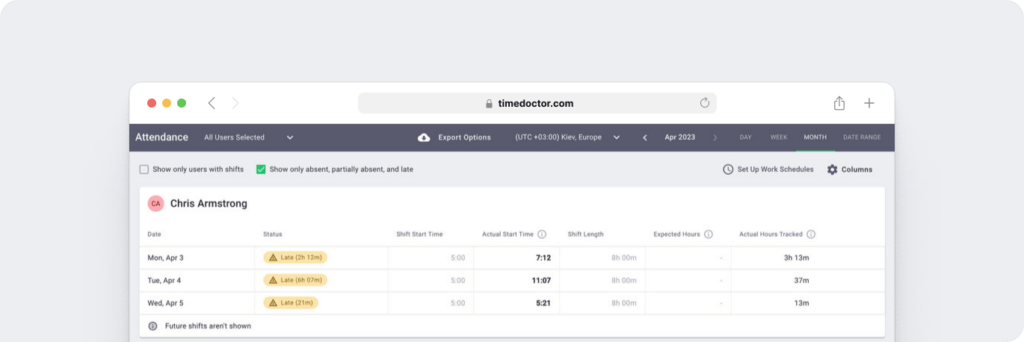
If you input team schedules into the platform, Time Doctor can compare actual time against scheduled time. The platform also reveals whether employees are tardy or absent so you can promptly spot and address absenteeism issues.
Automated time tracking
Monitoring start and stop times is just the beginning. Time Doctor also tracks how your team spends time throughout the workday, creating a complete report of projects and tasks. Are some employees spending longer than necessary on some assignments? A workflow check-in may resolve these issues.
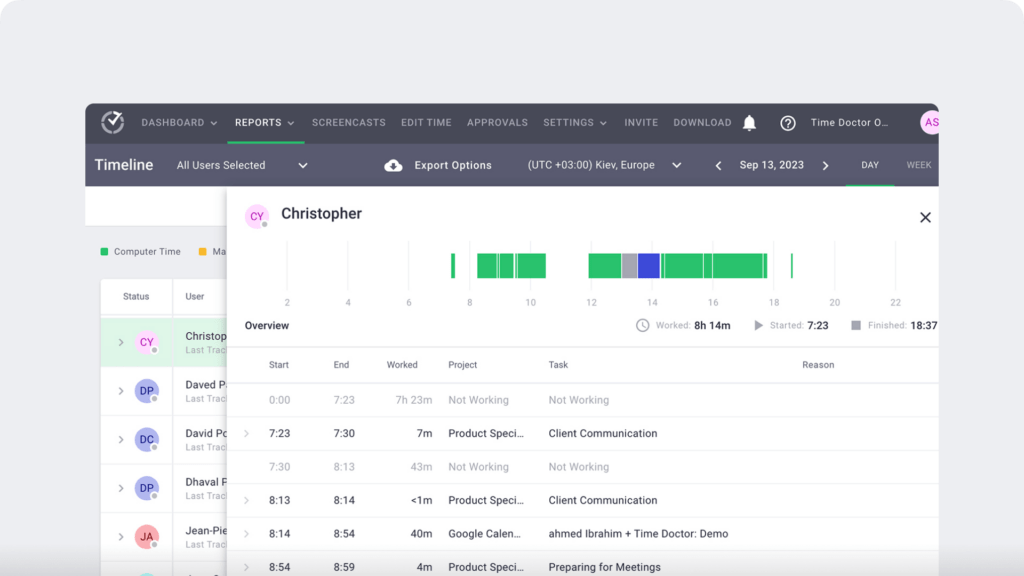
The platform monitors keyboard and mouse movement to gauge activity levels so you can keep track of idle time. Note that Time Doctor isn’t a keystroke logger and doesn’t record specific clicks or keys. Do some employees have increasingly high idle time numbers? You can use Time Doctor to see if their assigned tasks warrant these patterns.
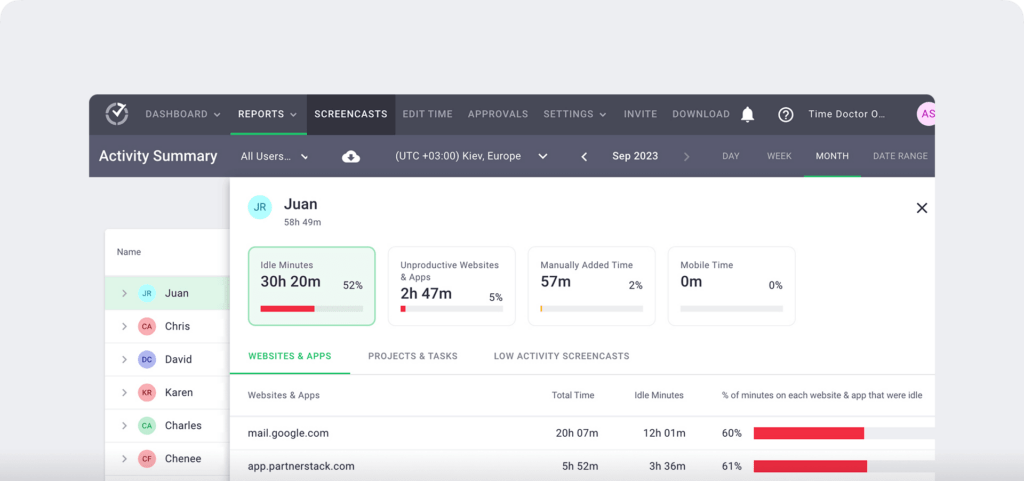
Time Doctor can also take periodic screenshots and monitor when employees go offline during the workday. Do some employees regularly spend a lot of time offline when they should be online consistently? A one-on-one conversation may reveal that their internet connection is to blame or they’re managing distractions at home.
Productivity insights
Wondering which websites and apps your team uses to do their jobs? Time Doctor automatically maintains a list of websites and apps employees use during the workday. It aligns these sites and apps with tasks and projects so you can get more insight into your remote team’s workflows.
As an admin, you can label websites and apps as productive or unproductive. The sites your team needs to do their jobs would fall into the former group, while social media sites would typically fall into the latter.
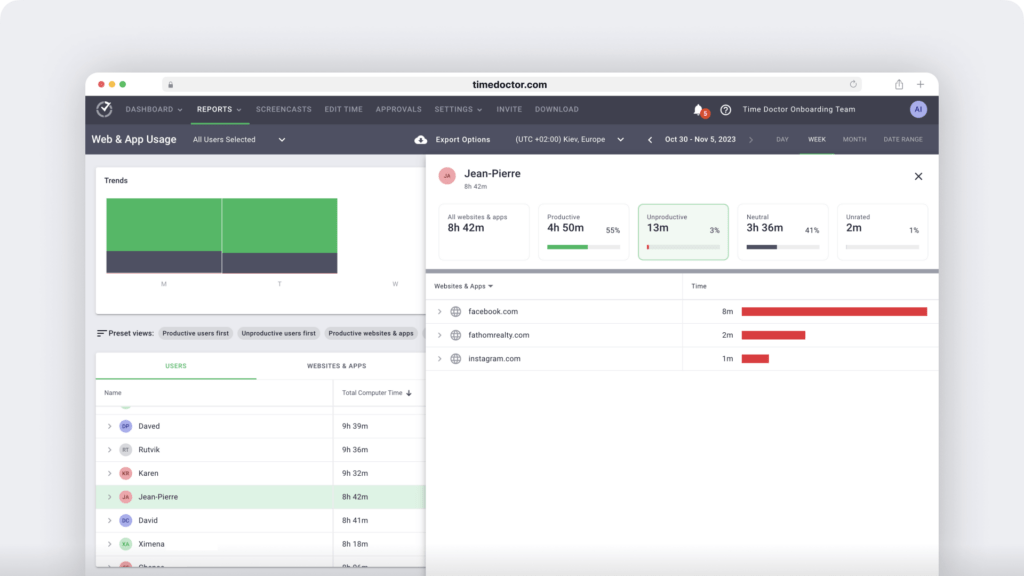
Using your custom settings, Time Doctor creates reports that reveal your team’s productivity levels. You can review this data by team or employee to get more insight into who’s actually working. How much can this feature impact your bottom line? As our client Bokdoc shares, “Time Doctor helped increase productivity by 15% per employee.”
Real-time insights
Curious what your team may be working on at a specific moment? Time Doctor provides real-time visibility into the projects and tasks your team manages, which increases transparency and accountability.

When you know what employees are doing during the workday, you can oversee their work without micromanaging each task. These insights can also help you set realistic expectations for response times across different time zones.
Work-life balance checks
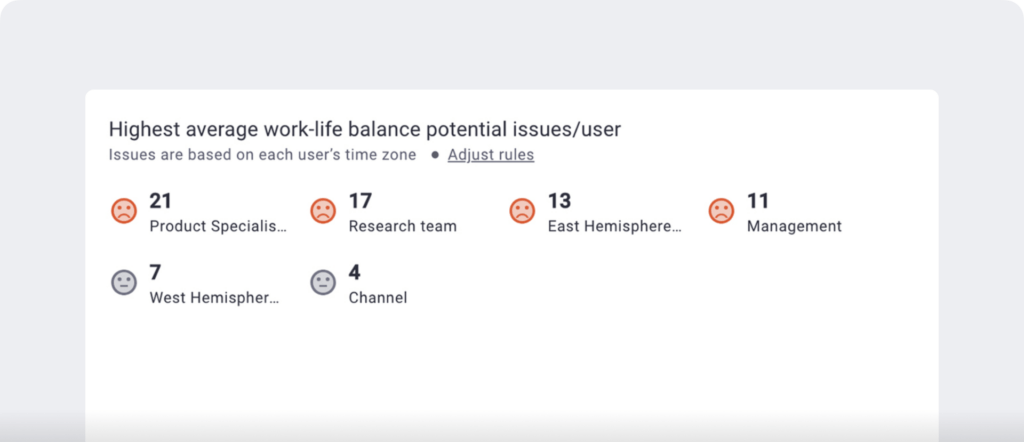
Once you input your custom warning signs for overwork, the platform automatically highlights employees who meet these criteria. Once you can see who’s working too much or too late, you can help these employees adjust their workflows or take time off before issues escalate.
As Time Doctor client Geoff Ainsworth says, “Work-life balance is a great feature that I would not be without and a real ally in talent retention.”
Next steps to get started with remote employee monitoring
Monitoring remote employees manually or with multiple tools adds a lot of unnecessary complexity. Simplify your tech stack with Time Doctor. With a single platform, you can monitor everything from attendance and activity to productivity and work-life balance.Ready to see how Time Doctor’s remote employee software can benefit your team? Book a demo to learn more.

Carlo Borja is the Content Marketing Manager of Time Doctor, a workforce analytics software for distributed teams. He is a remote work advocate, a father and a coffee junkie.


